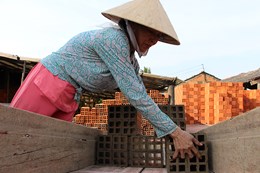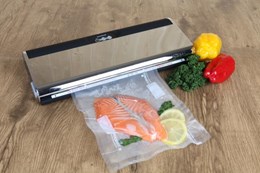-

On the morning of December 9, in Hanoi, Innovation, Green Transition, and Industry Promotion (Ministry of Industry and Trade) organized a technical consultation meeting on the methodology for reviewing, updating, and developing new energy efficiency benchmarking for the NPK fertilizer production, seafood processing, yarn production, and textile sectors.
-

The food processing industry is one of the most energy-intensive sectors, consuming vast amounts of electricity and fuel to transform raw ingredients into the products we consume daily. This high energy usage not only contributes to significant operational costs but also results in substantial greenhouse gas (GHG) emissions. Implementing energy-efficient practices is crucial for reducing both costs and environmental impact. This article explores various strategies to enhance energy efficiency in food processing, ultimately leading to a more sustainable and profitable industry.
-

The evaluation focuses on the achievements of the Rural Development Programme with regard to energy consumption efficiency and renewable energy production in the agriculture and food processing industry.
-

Investments by the governments of Canada and Ontario through the Sustainable Canadian Agricultural Partnership (Sustainable CAP) are resulting in over $16 million worth of energy cost savings projects to help food processing businesses increase energy efficiency and lower their costs.
-

In the seafood processing industry, energy costs are significant, accounting for about 30% of total product costs.
-

"Food processing industry - strategy sector study and subproject pipeline development for improving energy efficiency with integrated ozone and climate benefits" with budget of up to USD200 million.
-

Industry sector consumes huge energy and emits much environmental pollutants. The thermal power plants, metallurgy plant, cement, glass, food processing facilities all have the incinerator using coal, oil, gas or electricity to generate much heat during the manufacturing process. However, the really useful energy often accounts for only a small fraction of the total burned fuel.
-

Small and medium sized Enterprises (SMEs) in Vietnam account for 40% of total energy consumption in the industrial sector. The potentiality for energy efficiency is large, but local policies to promote savings for the sectors of brick, ceramics and food processing are not really showing the effects.
-

Can Tho city is the gateway of the Mekong River down stream. With the advantage of agriculture and aquaculture, Can Tho remains a centre of businesses in the food processing sector.
-

Experts of LCEE Project Mission worked with the Provincial Department of Industry & Trade, Can Tho Energy Conservation Center and the representatives of locally based banks in the area to reach the potential enterprises in food processing industry.
-

The LCEE Project has successfully organized the Workshop on the Green Investment Facility to support SMEs in the food processing industry in Can Tho. The Project officers provided instructions to companies involved in the project to complete the loan application dossiers.
-

Speaking at the meeting, Mr. Jen Lorentzen appreciated the positive and active cooperation of the Ministry of Industry and Trade in its deployment of the LCEE project to small and medium enterprises in three sectors: brick, ceramics and food processing.
-

Oerlikon Leybold Vacuum exhibits food processing vacuum solutions at the CFIA Rennes, France and the ANUGA Foodtec, Germany. Oerlikon Leybold Vacuum is supplying the Food Processing Industry with advanced vacuum solutions
-

From 2006 to 2010, the project "Promoting Energy Conservation in Small and Medium Scale Enterprise - PECSME", funded by the Global Environment Fund and managed by the Ministry of Science and Technology, has implemented 201 projects in the brick manufacturing industry, 144 projects in ceramics - porcelain, 81 projects in the food processing industry, 35 projects in the textile-garment and 38 projects in the paper industry.
-

The Vinh Phuc Province Department of Science and Technology recently worked with the Promoting Energy Conservation in Small and Medium Scale Enterprise Project (PECSME) under the Ministry of Science and Technology to organize a training course on energy conservation in small and mediums-sized enterprises in the areas of textile-garment, food processing, paper and pulp.
-

Vinh Phuc has more than 2,200 enterprises, of which two thirds are small and medium. There is a wide variety of industries such as food processing, textile, leather, wood, forestry, paper, and steel. Especially, Vinh Phuc is one of the provinces with the highest output of baked tile and brick in our country. Specifically, with about 900 manual brick facilities over nine districts, Vinh Phuc’s tile brick output is around 900 million pieces per year.
-

Cassava is widely known as a popular food used for breeding activity and in some other food processing industries. Few people, however, know that cassava is now the main material for producing the E5 bio-gasoline. While preparing for the market introduction of E5 bio-gasoline, Petrol Viet Nam Corporation and PV OIL have already set up a plan to plant cassava to use as raw material for production of clean gasoline.

















 Webinar 2: “Financial Support for Energy Efficiency Enterprises – Opportunities and Challenges”
Webinar 2: “Financial Support for Energy Efficiency Enterprises – Opportunities and Challenges”
 Vietnamese enterprises achieve green growth and cut costs through energy efficiency
Vietnamese enterprises achieve green growth and cut costs through energy efficiency
 Capacity Building for Program Implementing Entity
Capacity Building for Program Implementing Entity
 Enhance Energy Efficiency Knowledge for Managers of Cement Industrial Enterprises
Enhance Energy Efficiency Knowledge for Managers of Cement Industrial Enterprises
 Capacity building for participating financial institutions in Ho Chi Minh City
Capacity building for participating financial institutions in Ho Chi Minh City
 Strengthening capacity for energy management officers of local government agencies
Strengthening capacity for energy management officers of local government agencies
 Strengthening Sales and Marketing Capacity for Energy Efficiency Equipment and Solution Suppliers
Strengthening Sales and Marketing Capacity for Energy Efficiency Equipment and Solution Suppliers